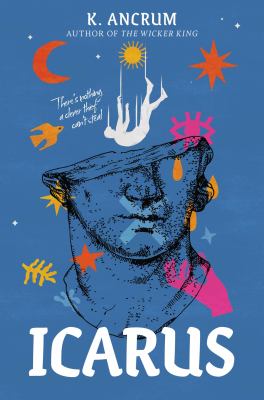
Icarus
By K. Ancrum
Young Adult Fiction
In Icaras by K. Ancrum, two boys living in different types of prisons embark on a journey toward freedom that begins with their fateful encounter.
Seventeen year old Icarus lives in a gloomy and joyless house with his father Angus. At his father’s behest, he breaks into a nearby mansion owned by Mr. Black, stealing priceless works of art and replacing them with fakes impeccably produced by his father. The scheme is Angus’s attempt to seek revenge for Mr. Black’s role in his own wife’s death. Icarus has been instructed to keep his illegal evening activity secret at all costs. In response, Icarus has constructed a protective shell around himself. He devises a system to choose only one person from each of his classes at school to get to know. Physical touch is out of the question. In this way, he manages to keep people at arm’s length, yet not appear to be a loner.
One night Icarus breaks into what he thinks is an empty Black mansion. To his horror, he is caught in the act of thievery by a dancer with orange hair as bright as the sun. It turns out that this is Helios, Mr. Black’s son, who is living there under house arrest. He has been tethered with an alarmed ankle monitor, and his iron-fisted father has taken away his phone and all other connections to the outside world. Helios, painstakingly lonely, strikes a bargain with Icarus in which he will not report the crime if Icarus agrees to be his friend. Icarus begins breaking in not to steal art, but to see Helios. A friendship develops gradually into something more. When Icarus learns that Helios suffers severe physical abuse at the hands of his mercurial father, he hatches a risky and elaborate plan to set Helios free.
Icarus states that he was named by his botany-loving mother after a plant species. However, the parallels in the story to the mythological Icarus are undeniable. Icarus is pulled to Helios, but what melts away here is not his wings, but the protective shell he has constructed around himself. The gentle dance of Icarus allowing himself to be touched by Helios is perhaps the most poetic part of the novel. Icarus’s friends at school also help erode his protective shell through various acts of kindness. He decides eventually to confide in them about his evening activities and about Helios. Despite his trepidation of revealing this information, his friends are supportive and rally behind his scheme to free Helios. Although the ending is a hopeful one, there is, as in the myth, a very consequential fall that occurs late in the novel.
The story is told in very short chapters, many less than one full page. In a few cases, I would have enjoyed a bit more information, such as more about the death of Icarus’s mother, the backstory of Icarus’s friends (which were interesting in their own right), or how Helios got into trouble. However, although the text is sparse, what is presented is polished and nicely framed, just like works of art in a gallery. Perhaps that is the point. Ankrum presents us with a series of images that will leave a lasting impression, yet leave room for wonder. Icarus was a unique and enjoyable read, worthy of its Kirkus starred review. It seems this would appeal to fans of Aristotle and Dante Discover the Secrets of the Universe.
Reviewed by Bryan Latimer
Zauel Library